Geographical Classification of Saffron (Crocus Sativus L.) Using Total and Synchronous Fluorescence Combined with Chemometric Approaches
Abstract
1. Introduction
2. Materials and Methods
2.1. Chemicals and Saffron Samples
2.2. Saffron Extracts Preparation
2.3. UV–Vis Spectrophotometric Analyses of the Aqueous Extracts
2.4. EEM and SFS Data Acquisition
2.5. Chemometric Analyses of SFS Datasets
3. Results and Discussion
3.1. Spectrophotometric Measurements of Saffron Aqueous Extracts
3.2. Optimization of the Saffron Extracts Preparation for Fluorescence Analysis
3.2.1. Optimization of the Extraction Solvent
3.2.2. Optimization of the Saffron Weight
3.2.3. Optimization of the Extraction Time
3.3. Fingerprinting of Saffron Extracts Using Emission-Excitation Matrix (EEM)
3.4. Synchronous Fluorescence Spectra (SFS) of Saffron Extracts
3.5. Geographical Origin Discrimination of Saffron Samples
3.5.1. Principal Component Analysis (PCA) of the Synchronous Saffron Samples Spectra
3.5.2. Linear Discriminant Analysis (LDA) of the Synchronous Saffron Samples’ Spectra
4. Conclusions
Supplementary Materials
Author Contributions
Funding
Data Availability Statement
Acknowledgments
Conflicts of Interest
References
- Melnyk, J.P.; Wang, S.; Marcone, M.F. Chemical and Biological Properties of the World’s Most Expensive Spice: Saffron. Food Res. Int. 2010, 43, 1981–1989. [Google Scholar] [CrossRef]
- Hosseinzadeh, H. Saffron: A Herbal Medicine of Third Millennium. Jundishapur J. Nat. Pharm. Prod. 2014, 9, 1–2. [Google Scholar] [CrossRef] [PubMed]
- Razavi, B.M.; Hosseinzadeh, H. Saffron: A Promising Natural Medicine in the Treatment of Metabolic Syndrome: Saffron as a Natural Medicine in Metabolic Syndrome. J. Sci. Food Agric. 2017, 97, 1679–1685. [Google Scholar] [CrossRef]
- Valero-Vello, M.; Peris-Martínez, C.; García-Medina, J.J.; Sanz-González, S.M.; Ramírez, A.I.; Fernández-Albarral, J.A.; Galarreta-Mira, D.; Zanón-Moreno, V.; Casaroli-Marano, R.P.; Pinazo-Duran, M.D. Searching for the Antioxidant, Anti-Inflammatory, and Neuroprotective Potential of Natural Food and Nutritional Supplements for Ocular Health in the Mediterranean Population. Foods 2021, 10, 1231. [Google Scholar] [CrossRef]
- Shahnoushi, N.; Abolhassani, L.; Kavakebi, V.; Reed, M.; Saghaian, S. Economic Analysis of Saffron Production. In Saffron; Woodhead Publishing: Sawston, UK, 2020; pp. 337–356. ISBN 978-0-12-818638-1. [Google Scholar]
- Cardone, L.; Castronuovo, D.; Perniola, M.; Cicco, N.; Candido, V. Evaluation of Corm Origin and Climatic Conditions on Saffron (Crocus Sativus L.) Yield and Quality. J. Sci. Food Agric. 2019, 99, 5858–5869. [Google Scholar] [CrossRef]
- Cardone, L.; Castronuovo, D.; Perniola, M.; Cicco, N.; Candido, V. Saffron (Crocus Sativus L.), the King of Spices: An Overview. Sci. Hortic. 2020, 272, 109560. [Google Scholar] [CrossRef]
- Ordoudi, S.A.; Cagliani, L.R.; Melidou, D.; Tsimidou, M.Z.; Consonni, R. Uncovering a Challenging Case of Adulterated Commercial Saffron. Food Control 2017, 81, 147–155. [Google Scholar] [CrossRef]
- Koocheki, A.; Milani, E. Saffron Adulteration. In Saffron; Woodhead Publishing: Sawston, UK, 2020; pp. 321–334. ISBN 978-0-12-818638-1. [Google Scholar]
- Kiani, S.; Minaei, S.; Ghasemi-Varnamkhasti, M. Instrumental Approaches and Innovative Systems for Saffron Quality Assessment. J. Food Eng. 2018, 216, 1–10. [Google Scholar] [CrossRef]
- Danezis, G.P.; Tsagkaris, A.S.; Camin, F.; Brusic, V.; Georgiou, C.A. Food Authentication: Techniques, Trends & Emerging Approaches. Trends Anal. Chem. 2016, 85, 123–132. [Google Scholar] [CrossRef]
- Biancolillo, A.; Maggi, M.A.; De Martino, A.; Marini, F.; Ruggieri, F.; D’Archivio, A.A. Authentication of PDO Saffron of L’Aquila (Crocus Sativus L.) by HPLC-DAD Coupled with a Discriminant Multi-Way Approach. Food Control 2020, 110, 107022. [Google Scholar] [CrossRef]
- Biancolillo, A.; Marini, F.; D’Archivio, A.A. Geographical Discrimination of Red Garlic (Allium Sativum L.) Using Fast and Non-Invasive Attenuated Total Reflectance-Fourier Transformed Infrared (ATR-FTIR) Spectroscopy Combined with Chemometrics. J. Food Compos. Anal. 2020, 86, 103351. [Google Scholar] [CrossRef]
- Bergomi, A.; Comite, V.; Santagostini, L.; Guglielmi, V.; Fermo, P. Determination of Saffron Quality through a Multi-Analytical Approach. Foods 2022, 11, 3227. [Google Scholar] [CrossRef]
- Ibourki, M.; Gharby, S.; Sakar, E.H.; Hani, O.E.; Digua, K.; Amine, A.; Ahmed, M.N.; Charrouf, Z.; Guillaume, D.; Hammadi, A.E. Elemental Profiling and Geographical Differentiation of Saffron (Crocus Sativus L.) Using Inductively Coupled Plasma-Optical Emission Spectroscopy (ICP-OES) and Principal Component Analysis. Chem. Data Collect. 2022, 41, 100937. [Google Scholar] [CrossRef]
- Cozzolino, R.; Stocchero, M.; Perestrelo, R.; Câmara, J.S. Comprehensive Evaluation of the Volatomic Fingerprint of Saffron from Campania towards Its Authenticity and Quality. Foods 2022, 11, 366. [Google Scholar] [CrossRef] [PubMed]
- Wadood, S.A.; Boli, G.; Xiaowen, Z.; Hussain, I.; Yimin, W. Recent Development in the Application of Analytical Techniques for the Traceability and Authenticity of Food of Plant Origin. Microchem. J. 2020, 152, 104295. [Google Scholar] [CrossRef]
- Shaikh, S.; O’Donnell, C. Applications of Fluorescence Spectroscopy in Dairy Processing: A Review. Curr. Opin. Food Sci. 2017, 17, 16–24. [Google Scholar] [CrossRef]
- Sikorska, E.; Khmelinskii, I.; Sikorski, M. Fluorescence Spectroscopy and Imaging Instruments for Food Quality Evaluation. In Evaluation Technologies for Food Quality; Woodhead Publishing: Sawston, UK, 2019; pp. 491–533. ISBN 978-0-12-814217-2. [Google Scholar]
- D’Archivio, A.A.; Maggi, M.A. Geographical Identification of Saffron (Crocus Sativus L.) by Linear Discriminant Analysis Applied to the UV–Visible Spectra of Aqueous Extracts. Food Chem. 2017, 219, 408–413. [Google Scholar] [CrossRef]
- Li, Y.; Shen, Y.; Yao, C.; Guo, D. Quality Assessment of Herbal Medicines Based on Chemical Fingerprints Combined with Chemometrics Approach: A Review. J. Pharm. Biomed. Anal. 2020, 185, 113215. [Google Scholar] [CrossRef]
- Tahir, H.E.; Arslan, M.; Mahunu, G.K.; Mariod, A.A.; Wen, Z.; Xiaobo, Z.; Xiaowei, H.; Jiyong, S.; El-Seedi, H. Authentication of the Geographical Origin of Roselle (Hibiscus Sabdariffa L.) Using Various Spectroscopies: NIR, Low-Field NMR and Fluorescence. Food Control 2020, 114, 107231. [Google Scholar] [CrossRef]
- Zgoła-Grześkowiak, A.; Werner, J.; Jeszka-Skowron, M.; Czarczyńska-Goślińska, B. Determination of Parabens in Cosmetic Products Using High Performance Liquid Chromatography with Fluorescence Detection. Anal. Methods 2016, 8, 3903–3909. [Google Scholar] [CrossRef]
- Rasheed, T.; Bilal, M.; Nabeel, F.; Iqbal, H.M.N.; Li, C.; Zhou, Y. Fluorescent Sensor Based Models for the Detection of Environmentally-Related Toxic Heavy Metals. Sci. Total Environ. 2018, 615, 476–485. [Google Scholar] [CrossRef]
- Dankowska, A. Advances in Fluorescence Emission Spectroscopy for Food Authenticity Testing. In Advances in Food Authenticity Testing; Woodhead Publishing: Sawston, UK, 2016; pp. 117–145. ISBN 978-0-08-100220-9. [Google Scholar]
- Hu, L.; Ma, S.; Yin, C. Discrimination of Geographical Origin and Detection of Adulteration of Kudzu Root by Fluorescence Spectroscopy Coupled with Multi-Way Pattern Recognition. Spectrochim. Acta Part A Mol. Biomol. Spectrosc. 2018, 193, 87–94. [Google Scholar] [CrossRef] [PubMed]
- Long, W.-J.; Wu, H.-L.; Wang, T.; Dong, M.-Y.; Chen, L.-Z.; Yu, R.-Q. Fast Identification of the Geographical Origin of Gastrodia Elata Using Excitation-Emission Matrix Fluorescence and Chemometric Methods. Spectrochim. Acta Part A Mol. Biomol. Spectrosc. 2021, 258, 119798. [Google Scholar] [CrossRef] [PubMed]
- Włodarska, K.; Khmelinskii, I.; Sikorska, E. Authentication of Apple Juice Categories Based on Multivariate Analysis of the Synchronous Fluorescence Spectra. Food Control 2018, 86, 42–49. [Google Scholar] [CrossRef]
- Dankowska, A.; Domagała, A.; Kowalewski, W. Quantification of Coffea Arabica and Coffea Canephora Var. Robusta Concentration in Blends by Means of Synchronous Fluorescence and UV-Vis Spectroscopies. Talanta 2017, 172, 215–220. [Google Scholar] [CrossRef]
- Tan, J.; Li, R.; Jiang, Z.-T.; Tang, S.-H.; Wang, Y.; Shi, M.; Xiao, Y.-Q.; Jia, B.; Lu, T.-X.; Wang, H. Synchronous Front-Face Fluorescence Spectroscopy for Authentication of the Adulteration of Edible Vegetable Oil with Refined Used Frying Oil. Food Chem. 2017, 217, 274–280. [Google Scholar] [CrossRef]
- Abu-Izneid, T.; Rauf, A.; Khalil, A.A.; Olatunde, A.; Khalid, A.; Alhumaydhi, F.A.; Aljohani, A.S.M.; Sahab Uddin, M.; Heydari, M.; Khayrullin, M.; et al. Nutritional and Health Beneficial Properties of Saffron (Crocus Sativus L.): A Comprehensive Review. Crit. Rev. Food Sci. Nutr. 2022, 62, 2683–2706. [Google Scholar] [CrossRef]
- Koocheki, A.; Khajeh-Hosseini, M. (Eds.) Saffron: Science, Technology and Health; Woodhead Publishing: Oxford, UK, 2020; ISBN 978-0-12-818638-1. [Google Scholar]
- Tajik, S.; Zarinkamar, F.; Soltani, B.M.; Nazari, M. Induction of Phenolic and Flavonoid Compounds in Leaves of Saffron (Crocus Sativus L.) by Salicylic Acid. Sci. Hortic. 2019, 257, 108751. [Google Scholar] [CrossRef]
- Belyagoubi, L.; Loukidi, B.; Belyagoubi-Benhammou, N.; Gismondi, A.; Di Marco, G.; D’Agostino, A.; Canini, A.; Benmahieddine, A.; Rouigueb, K.; Ben Menni, D.; et al. Valorization of Algerian Saffron: Stigmas and Flowers as Source of Bioactive Compounds. Waste Biomass Valor 2021, 12, 6671–6683. [Google Scholar] [CrossRef]
- Hashemi Gahruie, H.; Parastouei, K.; Mokhtarian, M.; Rostami, H.; Niakousari, M.; Mohsenpour, Z. Application of Innovative Processing Methods for the Extraction of Bioactive Compounds from Saffron (Crocus Sativus) Petals. J. Appl. Res. Med. Aromat. Plants 2020, 19, 100264. [Google Scholar] [CrossRef]
- Caser, M.; Demasi, S.; Stelluti, S.; Donno, D.; Scariot, V. Crocus Sativus L. Cultivation in Alpine Environments: Stigmas and Tepals as Source of Bioactive Compounds. Agronomy 2020, 10, 1473. [Google Scholar] [CrossRef]
- Daoud, M.; Loukidi, B.; Taibi, W.; Guermouche, B.; Rouigueb, K.; Labeik, A.; Rachid, A.; Merzouk, H.; Gaouar, S.B.S. Phenotypic and Phytochemical Diversity of Saffron (Crocus Sativus L.). Genet. Biodivers. J. 2021, 4, 71–80. [Google Scholar] [CrossRef]
- Bukhari, S.I.; Manzoor, M.; Dhar, M.K. A Comprehensive Review of the Pharmacological Potential of Crocus Sativus and Its Bioactive Apocarotenoids. Biomed. Pharmacother. 2018, 98, 733–745. [Google Scholar] [CrossRef] [PubMed]
- Hashemi, P.; Erim, F.B. Analysis of Vitamin B2 in Saffron Stigmas (Crocus Sativus L) by Capillary Electrophoresis Coupled with Laser-Induced Fluorescence Detector. Food Anal. Methods 2016, 9, 2395–2399. [Google Scholar] [CrossRef]
- Rigi, H.; Mohtashami, L.; Asnaashari, M.; Emami, S.A.; Tayarani-Najaran, Z. Dermoprotective Effects of Saffron: A Mini Review. Curr. Pharm. Des. 2021, 27, 4693–4698. [Google Scholar] [CrossRef]
- Pandita, D. Saffron (Crocus Sativus L.): Phytochemistry, Therapeutic Significance and Omics-Based Biology. In Medicinal and Aromatic Plants; Woodhead Publishing: Sawston, UK, 2021; pp. 325–396. ISBN 978-0-12-819590-1. [Google Scholar]
- Khayyat, S.A. Phytochemical and Antimicrobial Studies of Saffron and Its Essential Oil. J. Comput. Theor. Nanosci. 2017, 14, 4204–4211. [Google Scholar] [CrossRef]
- Donaldson, L. Autofluorescence in Plants. Molecules 2020, 25, 2393. [Google Scholar] [CrossRef]
- García-Plazaola, J.I.; Fernández-Marín, B.; Duke, S.O.; Hernández, A.; López-Arbeloa, F.; Becerril, J.M. Autofluorescence: Biological Functions and Technical Applications. Plant Sci. 2015, 236, 136–145. [Google Scholar] [CrossRef]
- Talamond, P.; Verdeil, J.-L.; Conéjéro, G. Secondary Metabolite Localization by Autofluorescence in Living Plant Cells. Molecules 2015, 20, 5024–5037. [Google Scholar] [CrossRef]
- Silva, B.; Gonzaga, L.V.; Maltez, H.F.; Samochvalov, K.B.; Fett, R.; Costa, A.C.O. Elemental Profiling by ICP-MS as a Tool for Geographical Discrimination: The Case of Bracatinga Honeydew Honey. J. Food Compos. Anal. 2021, 96, 103727. [Google Scholar] [CrossRef]
- Varrà, M.O.; Husáková, L.; Patočka, J.; Ghidini, S.; Zanardi, E. Multi-Element Signature of Cuttlefish and Its Potential for the Discrimination of Different Geographical Provenances and Traceability. Food Chem. 2021, 356, 129687. [Google Scholar] [CrossRef] [PubMed]
- Granato, D.; Putnik, P.; Kovačević, D.B.; Santos, J.S.; Calado, V.; Rocha, R.S.; Cruz, A.G.D.; Jarvis, B.; Rodionova, O.Y.; Pomerantsev, A. Trends in Chemometrics: Food Authentication, Microbiology, and Effects of Processing. Compr. Rev. Food Sci. Food Saf. 2018, 17, 663–677. [Google Scholar] [CrossRef] [PubMed]
- Gupta, V.; Sharma, A.; Rai, P.K.; Gupta, S.K.; Singh, B.; Sharma, S.K.; Singh, S.K.; Hussain, R.; Razdan, V.K.; Kumar, D.; et al. Corm Rot of Saffron: Epidemiology and Management. Agronomy 2021, 11, 339. [Google Scholar] [CrossRef]
- Elhamdaoui, O.; El Orche, A.; Cheikh, A.; Laarej, K.; Karrouchi, K.; El Karbane, M.; Bouatia, M. Tracing the Geographical Origin of Moroccan Saffron by Mid-Infrared Spectroscopy and Multivariate Analysis. Braz. J. Anal. Chem. 2022, 9, 115–128. [Google Scholar] [CrossRef]
- Tabtabaei, S.; D’Archivio, A.A.; Maggi, M.A.; Brutus, M.; Bajracharya, D.H.; Konakbayeva, D.; Soleimani, A.; Brim, H.; Ashktorab, H. Geographical Classification of Iranian and Italian Saffron Sources Based on HPLC Analysis and UV–Vis Spectra of Aqueous Extracts. Eur. Food Res. Technol. 2019, 245, 2435–2446. [Google Scholar] [CrossRef]
- Avila-Sosa, R.; Nevárez-Moorillón, G.V.; Ochoa-Velasco, C.E.; Navarro-Cruz, A.R.; Hernández-Carranza, P.; Cid-Pérez, T.S. Detection of Saffron’s Main Bioactive Compounds and Their Relationship with Commercial Quality. Foods 2022, 11, 3245. [Google Scholar] [CrossRef]
- Pan, H.; Yu, H.; Wang, Y.; Liu, R.; Lei, H. Investigating Variations of Fluorescent Dissolved Organic Matter in Wastewater Treatment Using Synchronous Fluorescence Spectroscopy Combined with Principal Component Analysis and Two-Dimensional Correlation. Environ. Technol. 2018, 39, 2495–2502. [Google Scholar] [CrossRef]
- Esteki, M.; Shahsavari, Z.; Simal-Gandara, J. Use of Spectroscopic Methods in Combination with Linear Discriminant Analysis for Authentication of Food Products. Food Control 2018, 91, 100–112. [Google Scholar] [CrossRef]
- El Grah, F.Z.; Bennasser, S.M.; El Ghazali, H.; Ait Hammou, R.; Harrouni, C.; Daoud, S. Characterization of the Moroccan Saffron in Relation to Climate Soil and Water in Its Main Production Zones. J. Hortic. Postharvest Res. 2022, 5, 129–140. [Google Scholar] [CrossRef]
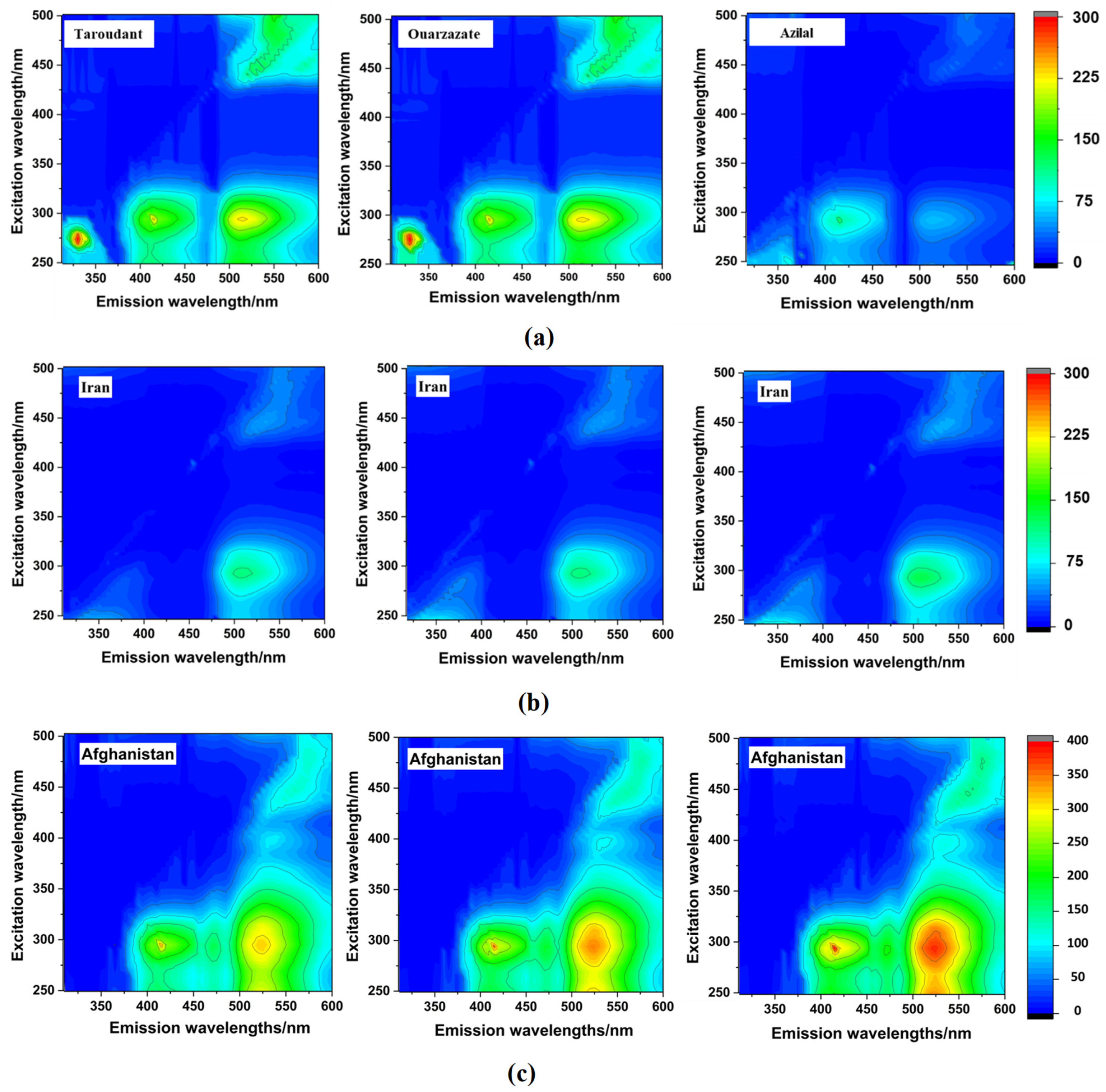
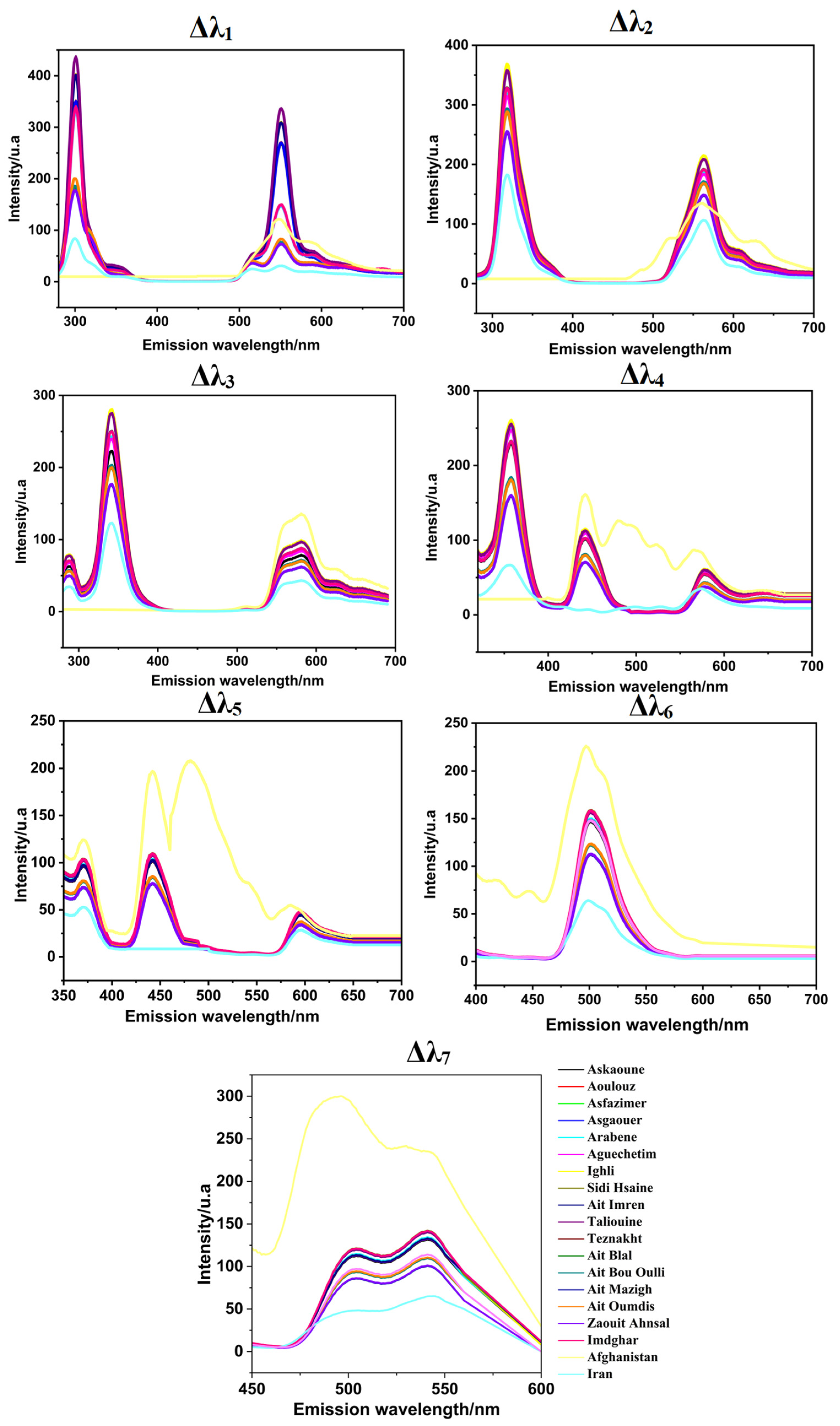
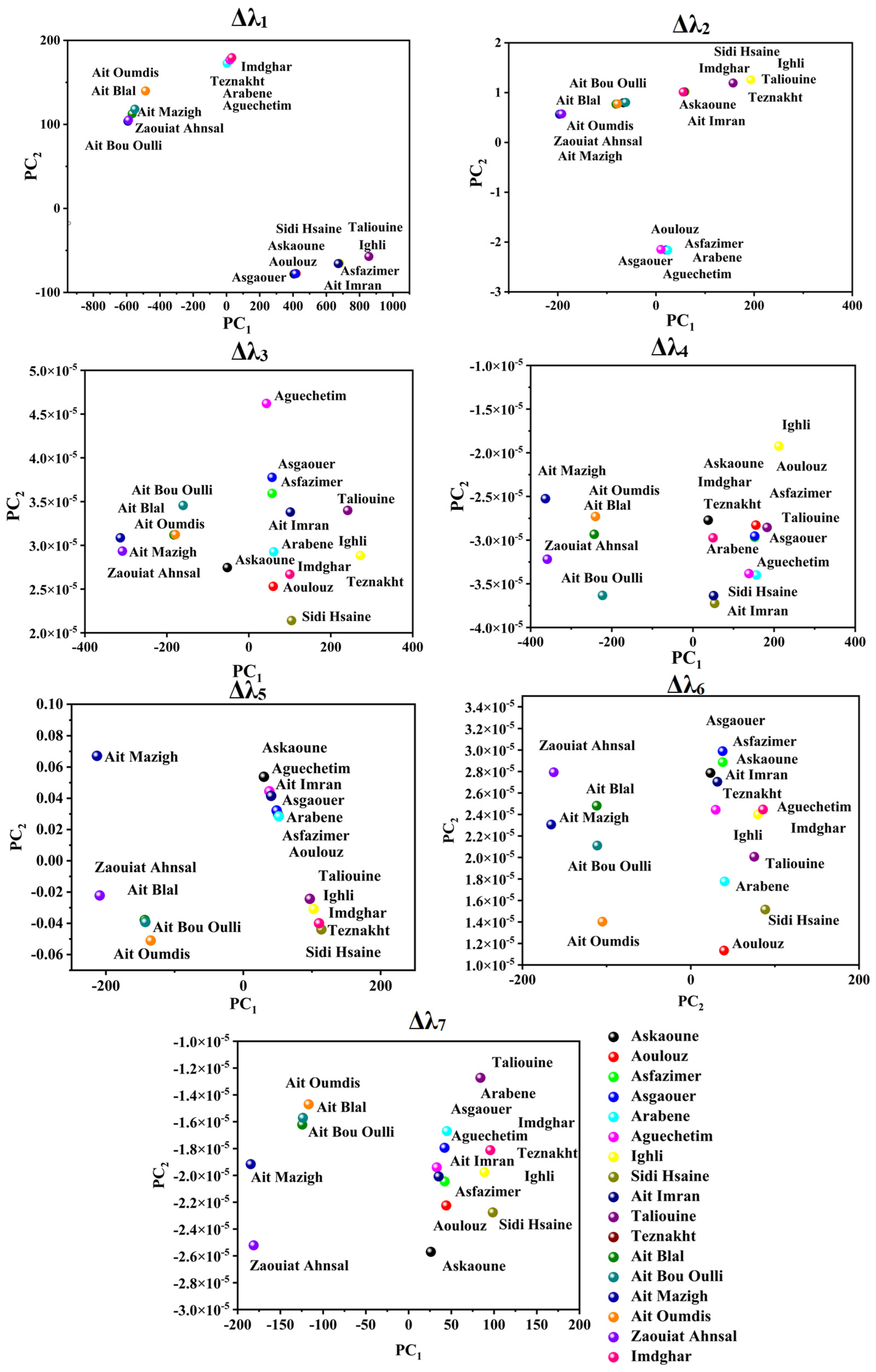
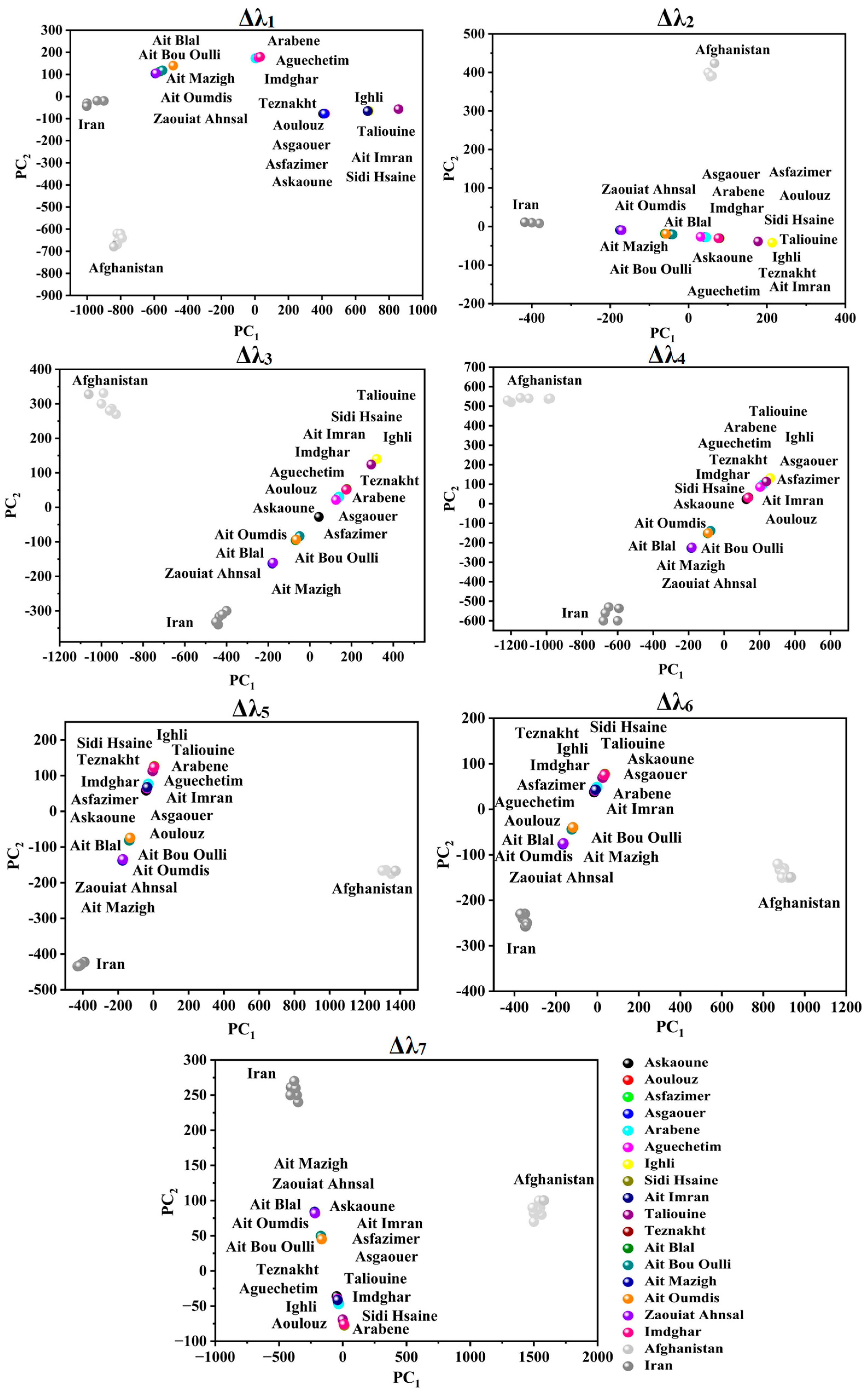
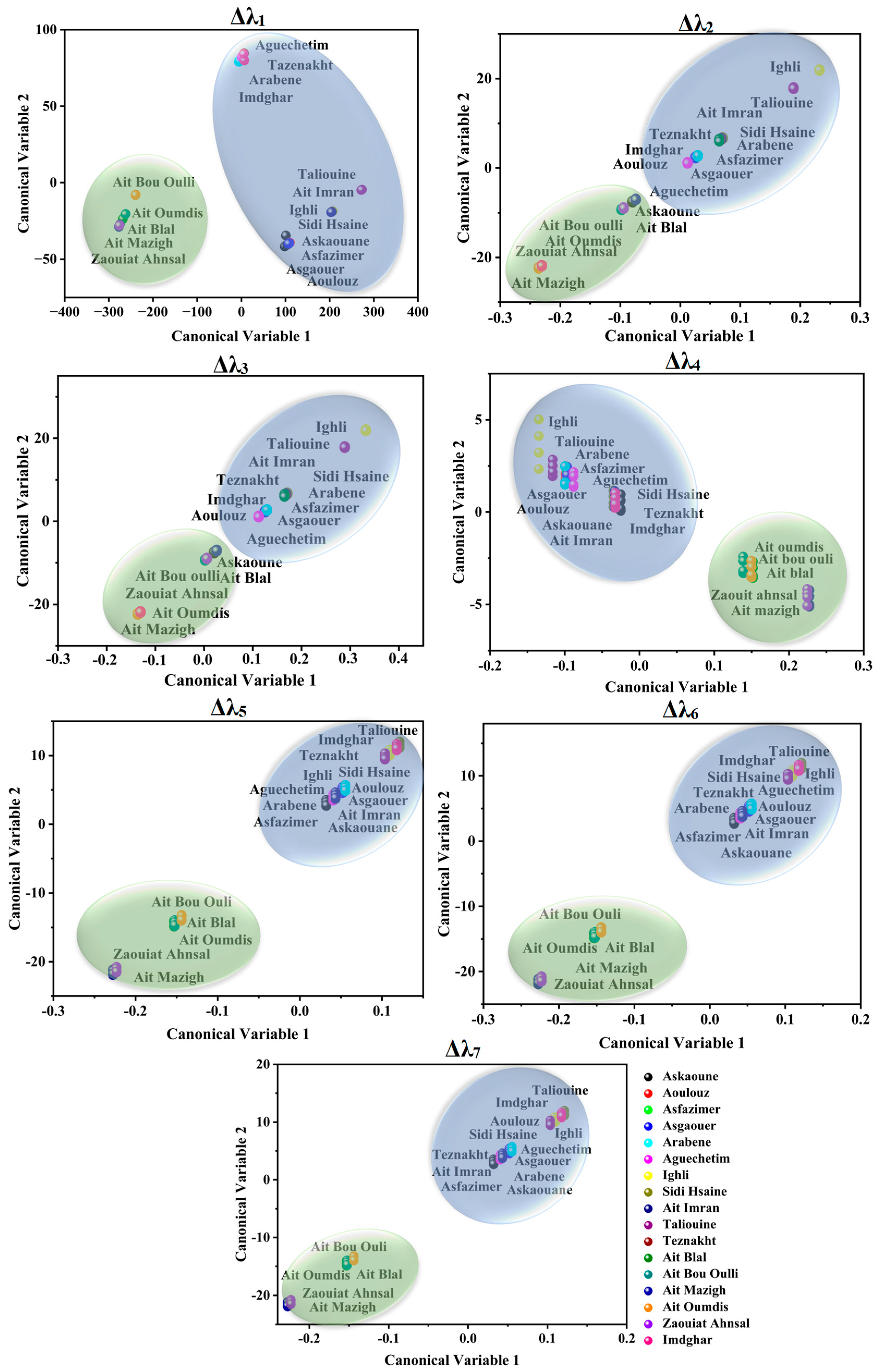
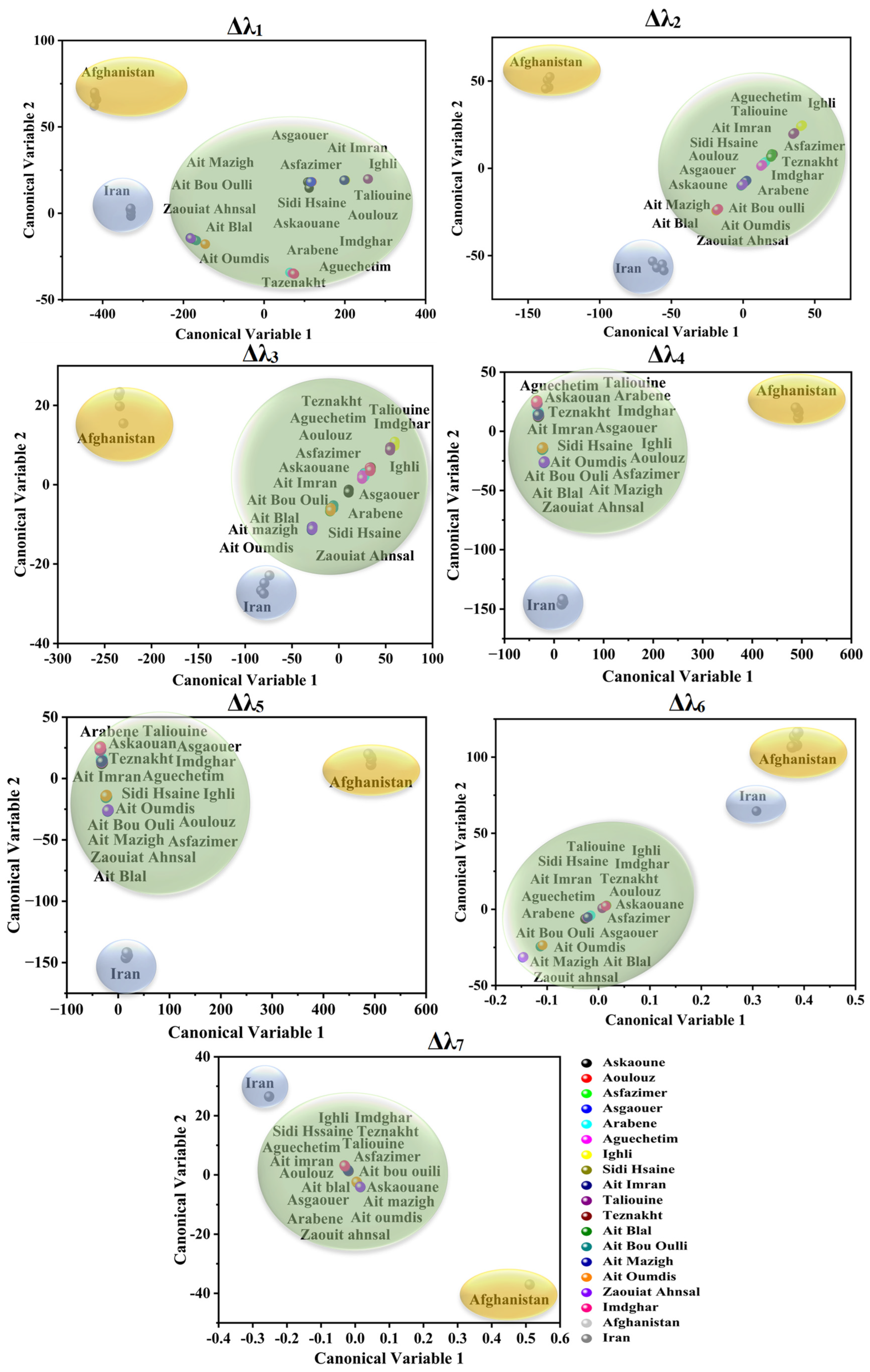
| Location | Province | Latitude | Longitude | Altitude (m) |
|---|---|---|---|---|
| Askaoune | Taroudant | 30°46′7″ N | 7°46′23″ W | 1857 |
| Aoulouz | 30°42′0″ N | 8°9′0″ W | 735 | |
| Asfazimer | 30°42′09″ N | 7°45′00″ W | 2009 | |
| Asgaouer | 30°35′53″ N | 7°39′8″ W | 1829 | |
| Arabene | 30°49′32″ N | 7°45′37″ W | 1992 | |
| Aguechetim | 30°48′27″ N | 7°47′18″ W | 1930 | |
| Ighli | 30°34′56″ N | 8°33′16″ W | 406 | |
| Sidi Hsaine | 30°28′10″ N | 7°46′19″ W | 1491 | |
| Ait Imran | 30°34′35″ N | 7°36′34″ W | 1687 | |
| Taliouine | 30°31′58″ N | 7°55′32″ W | 1029 | |
| Imdghar | Ouarzazate | 30°60′51″ N | 7°36′04″ W | 1535 |
| Tazenakht | 30°34′25″ N | 7°12′10″ W | 1410 | |
| Ait Mazigh | Azilal | 32°4′29″ N | 6°21′6″ W | 1140 |
| Zaouiat Ahansal | 31°49′57″ N | 6°06′20″ W | 1616 | |
| Ait Bou Oulli | 31°36′11″ N | 6°36′13″ W | 1673 | |
| Ait Blal | 31°41′27″ N | 6°42′59″ W | 1583 | |
| Ait Oumdis | 31°29′45″ N | 7°03′11″ W | 1283 | |
| Ait Tamlil | 31°28′48″ N | 6°56′24″ W | 1626 |
| Δλ1 | Δλ2 | Δλ3 | Δλ4 | Δλ5 | Δλ6 | Δλ7 | ||
|---|---|---|---|---|---|---|---|---|
| Moroccan saffron | PC1 | 95/89 | 97/96 | 98/97 | 99/98 | 97/97 | 99/98 | 98/97 |
| PC2 | 4/7 | 2/2 | 0.1/0.2 | 0.2/1 | 1/1 | 0.1/0.5 | 0.2/0.1 | |
| Moroccan, Afghan, and Iranian saffron | PC1 | 88/86 | 63/60 | 81/80 | 71/66 | 85/80 | 86/86 | 94/93 |
| PC2 | 10/8 | 34/34 | 17/5 | 26/14 | 14/10 | 12/12 | 5/5 | |
| Δλ1 | Δλ2 | Δλ3 | Δλ4 | Δλ5 | Δλ6 | Δλ7 | |
|---|---|---|---|---|---|---|---|
| Moroccan saffron | 80 | 99 | 98 | 98 | 95 | 94 | 95 |
| Moroccan, Afghan, and Iranian saffron | 83 | 70 | 83 | 83 | 84 | 95 | 96 |
Disclaimer/Publisher’s Note: The statements, opinions and data contained in all publications are solely those of the individual author(s) and contributor(s) and not of MDPI and/or the editor(s). MDPI and/or the editor(s) disclaim responsibility for any injury to people or property resulting from any ideas, methods, instructions or products referred to in the content. |
© 2023 by the authors. Licensee MDPI, Basel, Switzerland. This article is an open access article distributed under the terms and conditions of the Creative Commons Attribution (CC BY) license (https://creativecommons.org/licenses/by/4.0/).
Share and Cite
El Hani, O.; García-Guzmán, J.J.; Palacios-Santander, J.M.; Digua, K.; Amine, A.; Gharby, S.; Cubillana-Aguilera, L. Geographical Classification of Saffron (Crocus Sativus L.) Using Total and Synchronous Fluorescence Combined with Chemometric Approaches. Foods 2023, 12, 1747. https://doi.org/10.3390/foods12091747
El Hani O, García-Guzmán JJ, Palacios-Santander JM, Digua K, Amine A, Gharby S, Cubillana-Aguilera L. Geographical Classification of Saffron (Crocus Sativus L.) Using Total and Synchronous Fluorescence Combined with Chemometric Approaches. Foods. 2023; 12(9):1747. https://doi.org/10.3390/foods12091747
Chicago/Turabian StyleEl Hani, Ouarda, Juan José García-Guzmán, José María Palacios-Santander, Khalid Digua, Aziz Amine, Said Gharby, and Laura Cubillana-Aguilera. 2023. "Geographical Classification of Saffron (Crocus Sativus L.) Using Total and Synchronous Fluorescence Combined with Chemometric Approaches" Foods 12, no. 9: 1747. https://doi.org/10.3390/foods12091747
APA StyleEl Hani, O., García-Guzmán, J. J., Palacios-Santander, J. M., Digua, K., Amine, A., Gharby, S., & Cubillana-Aguilera, L. (2023). Geographical Classification of Saffron (Crocus Sativus L.) Using Total and Synchronous Fluorescence Combined with Chemometric Approaches. Foods, 12(9), 1747. https://doi.org/10.3390/foods12091747










